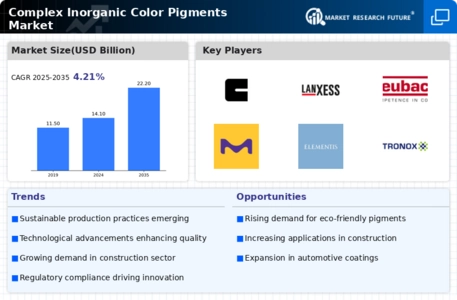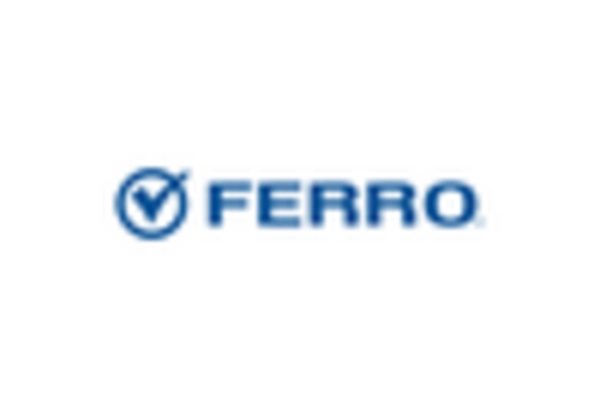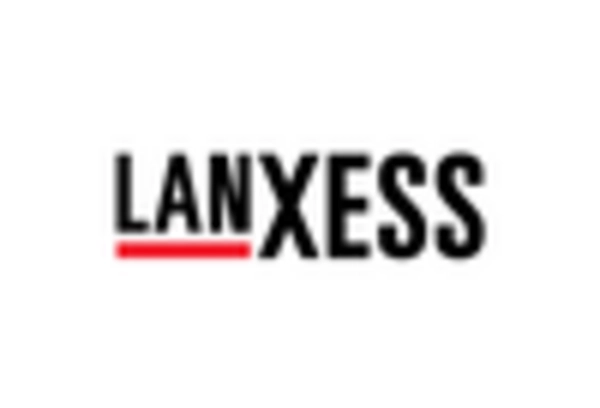Rising Demand in Automotive Sector
The automotive sector is experiencing a notable increase in demand for complex inorganic color pigments, primarily due to the growing emphasis on aesthetics and durability in vehicle coatings. The Complex Inorganic Color Pigments Market is projected to witness a compound annual growth rate of approximately 5% over the next few years, driven by the need for high-performance coatings that offer superior color stability and resistance to environmental factors. As automotive manufacturers seek to enhance the visual appeal of their products, the adoption of these pigments is likely to rise, thereby contributing to the overall growth of the market. Furthermore, the shift towards electric vehicles, which often require specialized coatings, may further bolster the demand for complex inorganic color pigments, indicating a robust future for this segment.
Expansion in Construction Activities
The construction industry is undergoing significant expansion, which is likely to have a profound impact on the Complex Inorganic Color Pigments Market. With urbanization trends continuing to rise, there is an increasing need for high-quality pigments in architectural coatings, concrete, and other construction materials. The market for complex inorganic color pigments is expected to grow as builders and architects prioritize durability and aesthetic appeal in their projects. Recent data suggests that the construction sector could see a growth rate of around 4% annually, which may translate into heightened demand for these pigments. This trend indicates that the complex inorganic color pigments will play a crucial role in enhancing the visual and functional properties of construction materials.
Increased Focus on Environmental Regulations
The Complex Inorganic Color Pigments Market is likely to benefit from the increasing focus on environmental regulations and sustainability. As industries strive to comply with stringent environmental standards, there is a growing preference for pigments that are non-toxic and environmentally friendly. Complex inorganic color pigments are often favored due to their stability and lower environmental impact compared to organic alternatives. This shift towards sustainable practices is expected to drive market growth, as manufacturers seek to align their products with eco-friendly initiatives. The market may see a rise in demand for these pigments, particularly in sectors such as coatings and plastics, where compliance with environmental regulations is becoming increasingly critical.
Technological Innovations in Pigment Production
Technological advancements in the production of complex inorganic color pigments are poised to enhance the efficiency and quality of these materials. Innovations such as improved synthesis methods and enhanced processing techniques are likely to lead to the development of pigments with superior properties, including better color strength and stability. The Complex Inorganic Color Pigments Market may experience growth as manufacturers adopt these technologies to meet the evolving demands of various applications, including coatings, plastics, and inks. Furthermore, the integration of automation and digital technologies in production processes could streamline operations, reduce costs, and improve product consistency, thereby fostering a more competitive market landscape.
Growing Demand in the Paints and Coatings Sector
The paints and coatings sector is a significant driver for the Complex Inorganic Color Pigments Market, as these pigments are essential for achieving desired color and performance characteristics in various applications. The market for paints and coatings is projected to grow steadily, with an estimated increase of around 3% annually, driven by rising consumer preferences for high-quality finishes and durability. Complex inorganic color pigments are particularly valued for their excellent lightfastness and chemical resistance, making them ideal for both interior and exterior applications. As the demand for innovative and high-performance coatings continues to rise, the complex inorganic color pigments market is likely to expand, reflecting the evolving needs of the industry.


















Leave a Comment